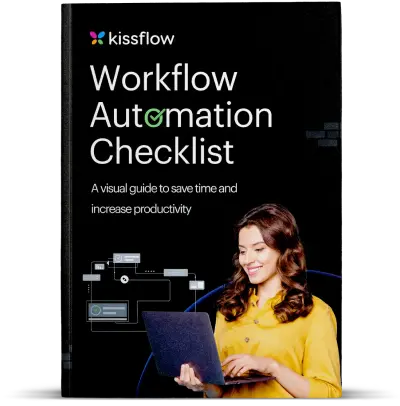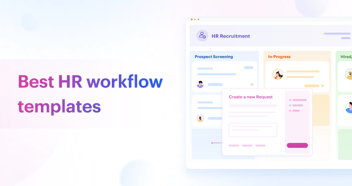
- >
- Workflow >
- Human-In-The-Loop AI Workflows: Striking The Balance Between Control And Automation
Human-In-The-Loop AI Workflows: Striking The Balance Between Control And Automation
Your loan approval system processes hundreds of applications daily. Most are straightforward. Credit scores, income verification, and debt ratios all line up clearly. These should auto-approve without human review, saving time and delivering faster customer service.
But some applications sit in the gray zone. The credit score is borderline. The income is non-traditional. There's a recent bankruptcy with a compelling explanation. These need human judgment. Not just any human. The right human with appropriate expertise and authority.
Human-in-the-loop workflows solve this challenge. They automate what should be automated while ensuring humans oversee decisions that require judgment, context, and accountability. It's not about choosing between AI-human collaboration and full automation. It's about designing hybrid workflow automation that leverages the strengths of both.
The limits of full automation
Complete automation works beautifully for routine, rule-based decisions. When every variable is quantifiable and every outcome is predictable, let the system handle it.
But business decisions rarely fit that description perfectly. There's context that matters but can't be captured in data. There's judgment that comes from experience but can't be coded into rules. There's accountability that requires human sign-off even when the decision is obvious.
Attempting full automation in these scenarios creates two problems. First, you build overly conservative rules that slow down legitimate requests to avoid edge case failures. Second, when something does go wrong, nobody owns the outcome. The system made the decision. The humans were just watching.
Research from Deloitte shows that 73 percent of executives believe that finding the right balance between automation and human judgment is critical to future success. The question isn't whether to automate. It's how to combine human control and automation intelligence effectively.
-> Learn more about workflow automation tools
Designing intelligent human-in-the-loop workflows
Effective hybrid workflow automation starts by categorizing decisions into three tiers based on complexity, risk, and business impact.
1. Tier one decisions have clear rules and low risk. These should fully automate. Expense reports within policy limits. Purchase orders from approved vendors. Customer service requests with standard solutions. The system handles these end-to-end without human involvement. This is where AI-human collaboration means AI does the work and humans set the policies.
2. Tier two decisions have some ambiguity or moderate risk. These use automation for processing and analysis but require human approval. The system does the heavy lifting: data gathering, validation, initial assessment, and recommendation. But a human reviews the recommendation and approves or rejects with full context. This represents true human-in-the-loop workflows where balance matters.
3. Tier three decisions have high stakes or significant ambiguity. These require human judgment throughout. Automation supports by providing information, flagging risks, and suggesting options. But humans drive the decision with control over the process and accountability for the outcome.
The key is designing workflows that automatically route requests to the appropriate tier. Most requests stay in tier one. Some escalate to tier two. Few reach tier three. The system adapts based on request characteristics, not fixed rules.
Automated triage that routes to human expertise
Human-in-the-loop workflows excel at intelligent routing. The system doesn't just flag requests for human review. It routes them to the right human based on expertise, workload, authority level, and availability.
A complex contract negotiation doesn't just go to "legal." It routes to the attorney with relevant industry experience who currently has capacity. A customer escalation doesn't just go to "management." It routes to the manager with history with that customer and authority to resolve the specific issue. This intelligence in hybrid workflow orchestration ensures the right level of human control at each decision point.
The routing logic learns from outcomes through AI-human collaboration. When certain attorneys consistently handle specific contract types faster, the system routes similar contracts to them. When certain managers excel at resolving particular customer issues, they get prioritized for those escalations.
Organizations implementing intelligent routing reduce average resolution time by 35 percent compared to manual assignment, according to Forrester research. The right expertise applied to the right problem delivers better outcomes faster while maintaining appropriate human control.
Providing context for informed human decisions
When a request escalates to human review in human-in-the-loop workflows, the reviewer shouldn't start from scratch. The automation should provide complete context, analysis, and recommendations that enable fast, informed decisions.
The system compiles all relevant information: request details, supporting documentation, policy requirements, similar past cases, risk factors, and potential implications. It performs initial analysis: policy compliance check, risk assessment, financial impact calculation, and timeline considerations. It provides a recommendation with confidence level and reasoning.
The human reviewer sees everything needed to make a decision without hunting through multiple systems. They can accept the recommendation, modify it, or reject it. But they're making an informed decision with full balance of automated analysis and human judgment.
This approach dramatically improves decision quality and speed in hybrid workflow automation. Reviewers spend 80 percent less time gathering information and 80 percent more time actually judging the decision. Organizations report 40 percent faster decision cycles with higher consistency, according to McKinsey research.
Defining clear escalation triggers
Human-in-the-loop workflows need explicit rules about when automation escalates to human review. Vague escalation criteria create either too many escalations (humans become bottlenecks) or too few (risky decisions slip through).
Effective escalation triggers focus on genuine ambiguity or risk, not arbitrary thresholds. Instead of "escalate all invoices over $50,000," the trigger might be "escalate invoices over $50,000 from new vendors or that differ significantly from the purchase order." The intelligence lies in the nuance, delivering appropriate human control where it matters.
Multiple escalation conditions can apply simultaneously. A loan application might escalate based on credit score, debt-to-income ratio, employment history, or unusual circumstances. The system evaluates all conditions and routes appropriately, enabling AI-human collaboration that's both efficient and safe.
The escalation logic should be transparent and auditable. Reviewers need to understand why a request escalated. This transparency builds trust in the hybrid workflow automation and enables continuous improvement of escalation criteria based on review outcomes.
Maintaining audit trails that show human accountability
In regulated industries, knowing who made a decision and why is as important as the decision itself. Human-in-the-loop workflows create complete audit trails that satisfy compliance requirements while supporting human control and accountability.
The system logs when a request entered human review, who reviewed it, what information they considered, what decision they made, and their rationale. If they deviated from the system recommendation, the audit trail captures why. This documentation proves that appropriate human oversight occurred and that decisions followed established processes.
During audits or investigations, you can reconstruct exactly what happened. The audit trail shows the automation's recommendation, the human's decision, and the reasoning behind any deviation. This protects the organization and the individual decision-maker while demonstrating the balance of automation and human judgment.
Organizations with comprehensive audit trails in their human-in-the-loop workflows reduce audit preparation time by 50 percent while achieving better audit outcomes, according to PwC research. The trail isn't just compliance theater. It's evidence of effective hybrid workflow automation with appropriate human control.
Building confidence through gradual automation expansion
Organizations often struggle with how much to automate initially. Too little and you don't capture the benefits. Too much and you create risk or resistance.
Human-in-the-loop workflows enable gradual expansion. Start with aggressive human review. As confidence builds, expand auto-approval criteria. The transition is data-driven, not guesswork, maintaining balance throughout.
Initially, route most requests to human review with automation providing support. Track approval rates, deviation from recommendations, and outcomes. When auto-approval recommendations prove consistently correct for certain request types, expand auto-approval to include them. Maintain human control for higher-risk categories while automating the routine.
This approach builds organizational trust in AI-human collaboration. Teams see that automation recommendations are reliable. They become comfortable with expanding automation scope. The balance shifts naturally toward more automation without sacrificing oversight where it matters.
Organizations using this gradual approach achieve 60 percent higher automation adoption rates with lower resistance, according to Gartner research. The human-in-the-loop design makes automation feel like augmentation rather than replacement.
Handling exceptions that don't fit the model
Even the best hybrid workflow automation tools encounters requests that don't fit established patterns. These are the true edge cases where human intelligence and control are essential.
Human-in-the-loop workflows need explicit paths for handling these exceptions. The system should recognize when a request is genuinely unusual and route it for specialized handling. The routing should escalate to higher expertise levels or multi-person review committees for complex cases.
The human reviewer handling exceptions should have flexibility to create custom workflows when needed. They're not constrained by the automation's standard logic. They can involve additional stakeholders, request more information, or apply creative solutions while maintaining AI-human collaboration principles.
Importantly, exceptions become learning opportunities. When humans handle an edge case, the system should capture the resolution approach. Over time, enough similar exceptions might warrant adding new automation logic. The hybrid workflow automation evolves based on real-world complexity with appropriate human control guiding that evolution.
Balancing speed and oversight in time-sensitive workflows
Some decisions need to happen fast. Customer-facing requests can't wait in review queues. Operational decisions might have time-critical implications. Yet these decisions still need appropriate oversight with human control where it matters.
Human-in-the-loop workflows can implement time-based escalation rules with approval workflow system. Requests that aren't reviewed within defined timeframes automatically escalate or auto-approve based on risk assessment. This prevents bottlenecks while maintaining balance.
For truly time-critical decisions, the system might auto-approve with immediate notification to a human reviewer. The decision happens instantly. But a human reviews it shortly after and can reverse if necessary. This maintains speed while ensuring human oversight through AI-human collaboration, even if it's slightly delayed.
Organizations using time-sensitive hybrid workflow automation report 45 percent faster processing for urgent requests while maintaining appropriate controls, according to Bain research. The balance lies in matching review timing to business needs rather than applying one-size-fits-all oversight.
Building trust in automated recommendations
Human reviewers need to trust the system's recommendations to work effectively. That trust comes from transparency, consistency, and demonstrated accuracy in human-in-the-loop workflows.
The system should explain its recommendations, not just provide them. Show which factors influenced the decision. Indicate confidence levels. Highlight any concerns or uncertainties. This transparency enables informed human judgment and maintains appropriate control.
Track and display recommendation accuracy over time. When humans can see that system recommendations prove correct 95 percent of the time for certain request types, they trust those recommendations more. This builds confidence in the AI-human collaboration that drives effective hybrid workflow automation.
When recommendations prove wrong, the system should learn. Human overrides become training data that improves future recommendations. This continuous improvement demonstrates that the system gets better through the balance of automation and human oversight.
How Kissflow helps
Kissflow's enterprise workflow management platform enables you to design human-in-the-loop workflows that maintain the perfect balance between automation efficiency and human control. Build approval chains that automatically route requests based on complexity and risk. Create escalation rules that ensure the right expertise reviews each decision. Provide reviewers with complete context and recommendations while maintaining their authority to approve, modify, or reject.
The visual workflow builder makes it simple to define when automation should handle decisions independently and when human oversight is essential, giving you hybrid workflow automation software that leverages AI-human collaboration effectively while maintaining accountability and control.
Design workflows that balance automation and human judgment
Related Topics:
- Smarter Decisions, Faster Outcomes: The Role of Generative AI in Workflow Optimization
- Predictive Workflows: The Future of AI in Process Automation
- Adaptive Workflows: How AI Learns and Optimizes Your Processes Automatically
- Intelligent Approvals: How AI Streamlines Cross-Departmental Workflows
- Workflow Automation Meets NLP: How AI Understands and Executes Human Language

Kissflow's Complete Guide To Workflow Automation
Thank you for downloading the ebook!
Related Articles











